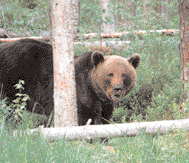|
Wildlife
Newsletter for the Township of Dalkey October 2014 - Michael Ryan |
 A brown bear in the woods Photo: M. Ryan |
I’ve
been in plenty of bird hides which are usually plain if solid structures
with bench seating and with small discrete windows designed so they
could be opened causing minimal disturbance to the creatures you’d
come to watch. But the hide we were entering was much bigger than any
bird hides I’d been in before, the windows didn’t open and
there were 12 bunk beds. The beds were a necessity since once you entered
this hide, between 5 and 6 in the evening, you weren’t allowed
outside the door again till 8.00am the following morning. Also, we had been warned many times in advance not to put on anything that might smell strongly, so no deodorant, perfume, aftershave or insect repellent sprays. This was because the creature we’d come to see, unlike birds, has a very highly developed sense of smell and the scent of humans could deter it from visiting. The animal we were hoping to see was a Brown Bear and we’d come to this hide in the middle of a remote forest in Estonia hoping to see it. |
|
Driving
back to the B&B we stopped to look at a raptor which had crossed
the road then saw a Ural owl quartering the farmland beside the road.
As we watched it in the fading light a Nightingale sang, a Cuckoo
called and a Corncrake made its ‘kraking’ call from a
meadow, a wonderful soundtrack and a perfect evocation of the magic
of springtime in old Europe. Our first night at the bear hide would
be the following day, Monday. In the morning we walked along a forest
road and Marko showed us trees where bears had scratched deep ruts
in the trunk and peeled off the bark. He warned us that if a bear
did appear we should stand perfectly still since running away would
trigger their natural predator reactions. There’s a well-known
whimsical saying that if running away from bears, or any other wild
animal that might be in pursuit, you don’t have to be the fastest
runner as long as you’re not the slowest but it wasn’t
something we wanted to put to the test. Despite their enormous size,
brown bears are extremely fast, having been clocked at speeds of 48
kilometres per hour. It’s well over 100 years since anyone was
killed by a bear in Estonia but many people get injured during accidental
encounters and if the bear has cubs it can be particularly dangerous
if you meet one. The bears won’t try to eat you, just frighten
you away by showing their dominance but a swipe from a bear paw could
do you serious damage. In late afternoon we parked on the edge of
the forest and walked a few kilometres along a trail to the hide.
There were four other tourists as well as three guides staying in
the hide and once we entered we all spoke in whispered tones and settled
down for a possible long wait. Apair of Pied Flycatchers busied themselves
at a nearby nest box and later a Great Spotted Woodpecker gave great
views at a feeding station on a tree just outside the hide. |
| The Raccoon Dog originates in East Asia but was intensely bred in Russia for its fur. It was released into many areas of Russia and the Baltic States during the midtwentieth century then spread all over Europe reaching France and Switzerland as well as the Nordic countries. It has reached high nuisance status in many countries where it preys on the eggs and young of ground nesting birds as well as taking many native amphibians. It has possibly caused the reduction in native mammals by outcompeting them for prey but another serious concern is the fact it can carry rabies. |
|